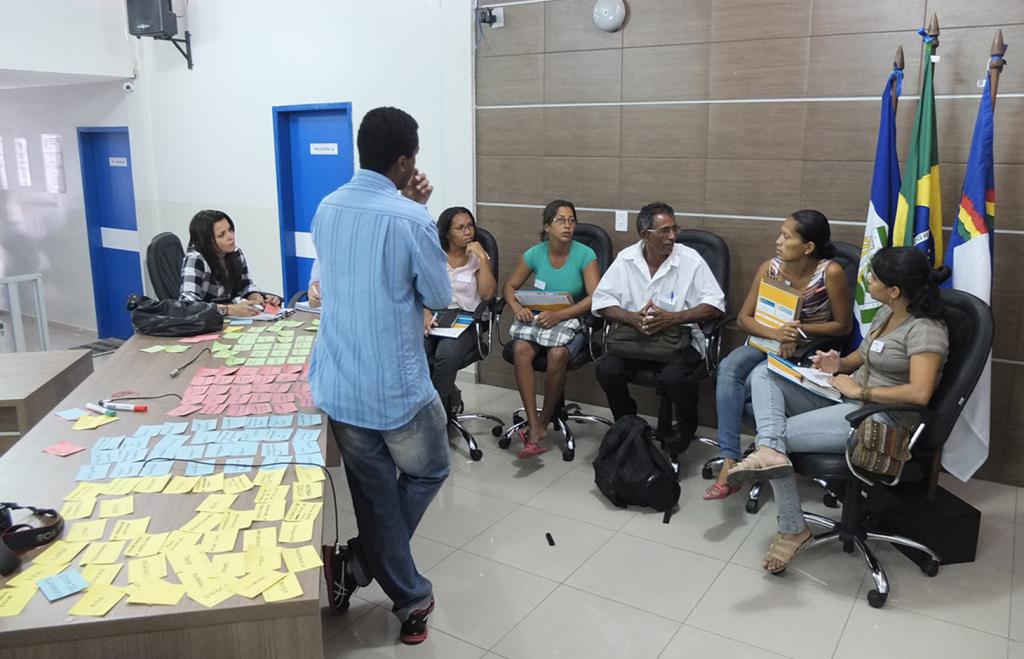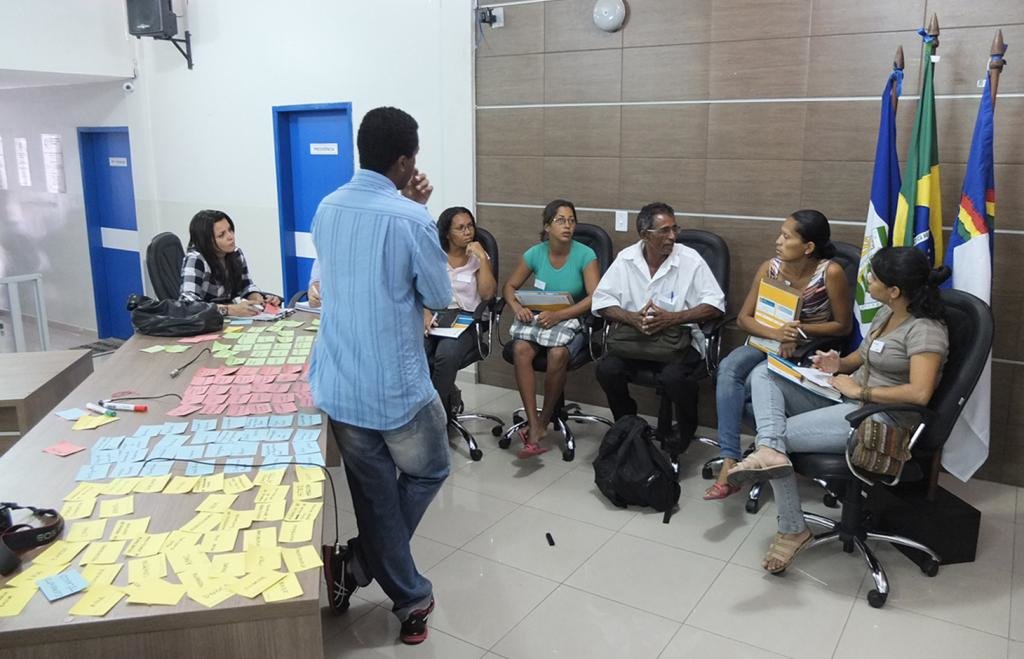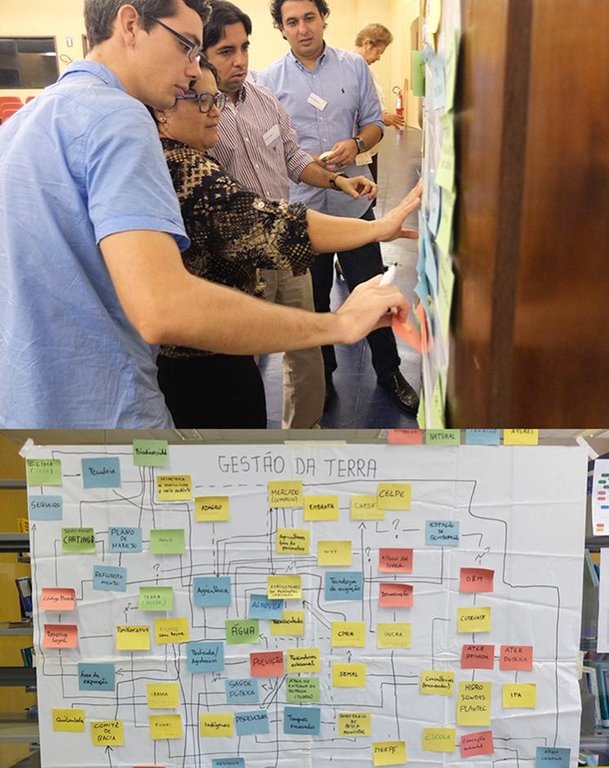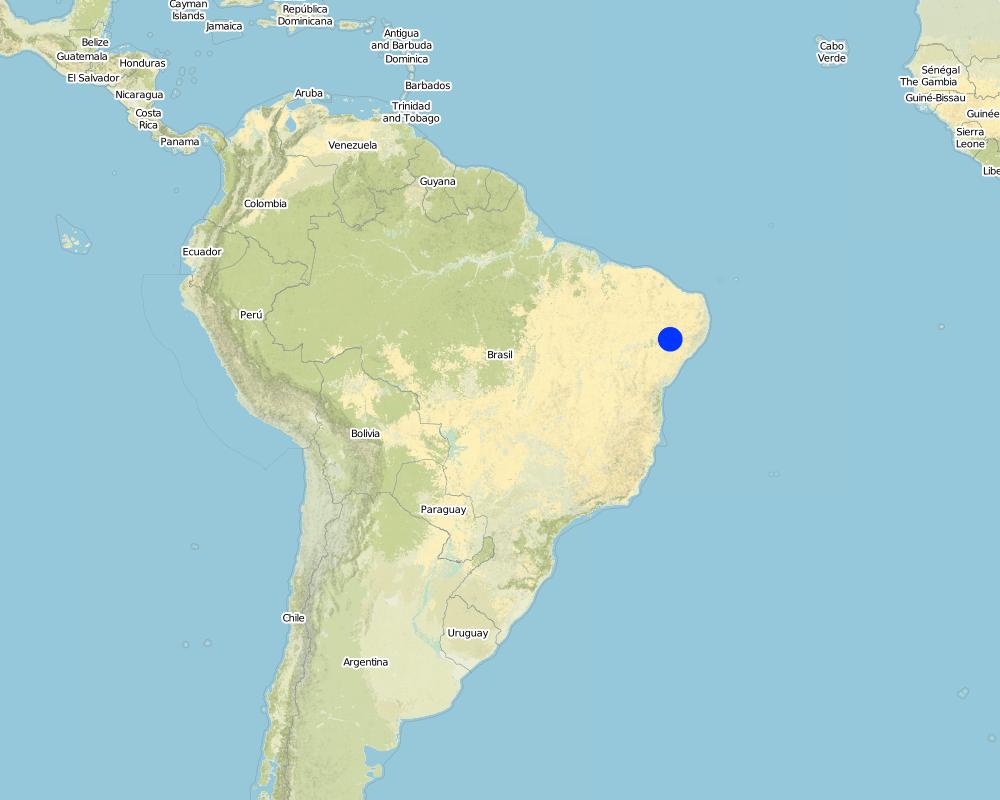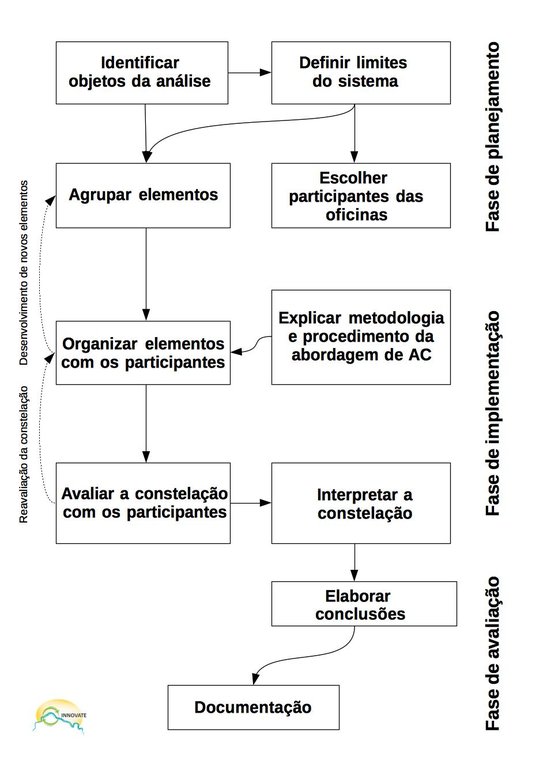Constellation Analysis [Brésil]
- Création :
- Mise à jour :
- Compilateur : Verena Rodorff
- Rédacteur : –
- Examinateur : Deborah Niggli
Análise de Constelação
approaches_1974 - Brésil
Voir les sections
Développer tout Réduire tout1. Informations générales
1.2 Coordonnées des personnes-ressources et des institutions impliquées dans l'évaluation et la documentation de l'Approche
Spécialiste GDT:
Nom du projet qui a facilité la documentation/ l'évaluation de l'Approche (si pertinent)
Book project: Making sense of research for sustainable land management (GLUES)1.3 Conditions relatives à l'utilisation par WOCAT des données documentées
Quand les données ont-elles été compilées (sur le terrain)?
23/06/2015
Le compilateur et la(les) personne(s) ressource(s) acceptent les conditions relatives à l'utilisation par WOCAT des données documentées:
Oui
2. Description de l'Approche de GDT
2.1 Courte description de l'Approche
Constellation Analysis is a tool used to clarify perceptions of different stakeholders about critical situations or problems. In workshops, participants visualize interrelationships between actors, as well as the associated natural, technical and regulatory factors.
2.2 Description détaillée de l'Approche
Description détaillée de l'Approche:
The Constellation Analysis method (CA) aims at a transparent, mutually accepted visualization of factors (‘elements’) that are systematically arranged under the method's four categories: actors; rules and concepts; natural elements; technical elements, with the type of their inter-relationships. The process enables consensus to be found between divergent positions, paving the way for better informed decision-making while facilitating a negotiated process of land management with potential changes/techniques.
During brainstorming and/or literature-based approach, different elements are determined and arranged visually on a board. Element categories are actors (e.g. farmers, energy supply company), rules and concepts (e.g. legal framework, plans and programs, regulations), natural factors (e.g. climate, vegetation, water) and technical factors (e.g. fertilizer, wastewater treatment, hydropower plant). Usually this is done by using differently coloured and shaped cards to help articulate ideas within a working group. Then, connections among and between the elements are discussed and the form of these interrelations are visualized as being (a) directed, (b) conflictive, (c) non-existent, (d) contradictory, (e) reluctant or (f) interactive. Through this approach the way towards developing solutions (or follow-up CAs) is guided.
The approach was applied at different scales and with different stakeholders with divergent professional expertise and educational levels, e.g. farmers, fishermen, employees of the government, representatives of indigenous tribes, associations, trade unions, and researchers. People found the methodology promising as it raises awareness and organizes information. Training in the methodology has been carried out amongst interested people at two universities, but not yet local development agents.
The visualization is carried out through an iterative group process. A moderator is needed to initiate the process by inviting the different stakeholders to a conducive location, and to facilitate the process. Exchange among participants is enhanced, and this leads to better understanding of different viewpoints in situations of tension or in the understanding of what has evolved through specific developments in the past. During a second analytical step, the main lessons of the visualization are extracted and documented. Here, missing factors/relationships, and consequently the need for action, are detected. For example, insufficient communication between actors could be uncovered, or it may be detected that planning programs need to be improved.
2.3 Photos de l'approche
2.5 Pays/ région/ lieux où l'Approche a été appliquée
Pays:
Brésil
Région/ Etat/ Province:
Pernambuco, Brazil
Autres spécifications du lieu :
Itaparica Reservoir, Petrolândia
Map
×2.6 Dates de début et de fin de l'Approche
Indiquez l'année de démarrage:
2012
Date (année) de fin de l'Approche (si l'Approche n'est plus appliquée):
2016
2.7 Type d'Approche
- fondé sur un projet/ programme
2.8 Principaux objectifs de l'Approche
The approach can be applied at different levels and for different issues or contexts: all perspectives can be represented and discussed. The application in this case was devised to be an iterative process of consecutive workshops first at the local irrigation project level, and then at the municipal, regional and national levels with the aim of analysing the inhibiting and driving forces behind the current situation in water management, in land management, and around production cycles in agriculture and aquaculture leading to action being taken or decisions made. Farmers and fishermen, employees of government, researchers and experts are considered as the relevant target group to be involved in participatory workshops. In the education sector, the approach can be applied for theses, for field work and for projects as an analytical interdisciplinary approach.
2.9 Conditions favorisant ou entravant la mise en œuvre de la(des) Technologie(s) appliquée(s) sous l'Approche
normes et valeurs sociales/ culturelles/ religieuses
- favorise
In some cases, segregation of social or gender groups, especially at the beginning of the exercise, can be helpful. No means has yet been found to reduce ‘mobile phone distraction’ in an acceptable way.
cadre institutionnel
- favorise
Argumentation promoting the value of the process may help to ‘sell’ the approach.
connaissances sur la GDT, accès aux supports techniques
- favorise
It may be possible to organize a pick-up service for participants or to choose an easy-access location.
charge de travail, disponibilité de la main-d'œuvre
- favorise
It is important to discuss potential dates in advance. Some people prefer weekends, others don’t. The lunch break is useful for more informal interaction. However others use the break to disappear.
autre
- favorise
The iterative process of the CA promotes a re-assessment of constellations during different group discussions. Views of dominant individuals can be modified in the iterative procedure, especially when participants with different standpoints and positions are involved. The goal is the mutual understanding of divergent positions towards entry points for change or adaptation.
3. Participation et rôles des parties prenantes impliquées dans l'Approche
3.1 Parties prenantes impliquées dans l'Approche et rôles
- exploitants locaux des terres / communautés locales
smallholders of local agricultural community
- Spécialistes de la GDT/ conseillers agricoles
- enseignants/ élèves/ étudiants
students only in observing role
- gouvernement national (planificateurs, décideurs)
3.2 Participation des exploitants locaux des terres/ communautés locales aux différentes phases de l'Approche
| Participation des exploitants locaux des terres/ communautés locales | Spécifiez qui était impliqué et décrivez les activités | |
|---|---|---|
| initiation/ motivation | passive | Interviews |
| planification | aucun | |
| mise en œuvre | interactive | Workshops |
| suivi/ évaluation | interactive | Workshops |
| research | interactive | Data analysis, lessons learnt, etc |
3.3 Diagramme/ organigramme (si disponible)
Description:
Simplified flowchart of the Constellation Analysis Approach.
Planning phase:
Clarify the objective or question behind the analysis. Then, have an overview research about first elements (assembling elements), e.g. which actors can give interesting input and how to contact them. Preparing material for the workshop(s): coloured cards, pens, whiteboard, etc.
Implementation phase:
Explain the objective and methodology to participants, the meaning of the elements: actors; rules and concepts; natural elements; technical elements and their different relations. Clarify rules of respecting each other. Arrange the elements. Evaluate the constellation together with participants, e.g. why are elements far or close to each other? Why are relations conflictive and how to overcome? Are elements or relations missing? Is all information available? What are the next step? Can recommendations be formulated?
Evaluation phase:
Were participants objective enough? How to interpret participant’s activity within the workshop? Which actors should be asked as well? Consolidate participants’ statements with literature and research and document. Documentation could be a photo or digitalized picture of results with an explanation based on literature.
Auteur:
Liron Steinmetz
3.4 Prises de décision pour la sélection de la Technologie/ des Technologies
Indiquez qui a décidé de la sélection de la Technologie/ des Technologies à mettre en œuvre:
- principalement les exploitants des terres soutenus par des spécialistes de la GDT
Expliquez:
Constellation Approach is not linked with a specific technology. Can be used in a planning phase in sustainable land management. Various methods, technologies and management approaches can be derived from the applied Constellation CA Approach, and can be specified depending on the SLM problem.
4. Soutien technique, renforcement des capacités et gestion des connaissances
4.1 Renforcement des capacités/ formation
Une formation a-t-elle été dispensée aux exploitants des terres/ autres parties prenantes?
Oui
Spécifiez qui a été formé:
- exploitants des terres
- personnels/ conseillers de terrain
Formats de la formation:
- workshops
Thèmes abordés:
detecting knowledge gaps and clarifying positions of players, and role of natural, technical and regulatory elements from multi-angled viewpoints/perspectives as core of the CA-Approach.
4.2 Service de conseils
Les exploitants des terres ont-ils accès à un service de conseils?
Oui
- workshops
4.3 Renforcement des institutions (développement organisationnel)
Des institutions ont elles été mises en place ou renforcées par le biais de l'Approche?
- non
4.4 Suivi et évaluation
Le suivi et l'évaluation font ils partie de l'Approche? :
Oui
Si oui, ce document est-il destiné à être utilisé pour le suivi et l'évaluation?
Non
4.5 Recherche
La recherche a-t-elle fait partie intégrante de l’Approche?
Oui
Spécifiez les thèmes:
- sociologie
- économie/ marketing
- écologie
- technologie
5. Financement et soutien matériel externe
5.1 Budget annuel de la composante GDT de l'Approche
Si le budget annuel précis n'est pas connu, indiquez une fourchette:
- < 2 000
Commentez (par ex. principales sources de financement/ principaux bailleurs de fonds):
German Federal Ministry of Education and Research (BMBF) 100%
5.2 Soutiens financiers/ matériels fournis aux exploitants des terres
Les exploitants des terres ont-ils reçu un soutien financier/ matériel pour la mise en œuvre de la Technologie/ des Technologies?
Non
5.3 Subventions pour des intrants spécifiques (incluant la main d'œuvre)
- aucun
Si la main d'œuvre fournie par les exploitants des terres était un intrant substantiel, elle était:
- volontaire
5.4 Crédits
Des crédits ont-ils été alloués à travers l'Approche pour les activités de GDT?
Non
5.5 Autres incitations ou instruments
D'autres incitations ou instruments ont-ils été utilisés pour promouvoir la mise en œuvre des Technologies de GDT?
Non
6. Analyses d'impact et conclusions
6.1 Impacts de l'Approche
Est-ce que l'Approche a aidé les exploitants des terres à mettre en œuvre et entretenir les Technologies de GDT?
- Non
- Oui, un peu
- Oui, modérément
- Oui, beaucoup
No immediate impact, however CA-Approach could prospectively contribute to improved sustainable land management and in particular governance.
Est-ce que l'Approche a autonomisé les groupes socialement et économiquement défavorisés?
- Non
- Oui, un peu
- Oui, modérément
- Oui, beaucoup
No immediate impact, however CA-Approach could prospectively contribute to an improved situation of socially and economically disadvantaged groups.
Did other land users / projects adopt the Approach?
- Non
- Oui, un peu
- Oui, modérément
- Oui, beaucoup
Interest from cooperating universities (UFPE-Universidade Federal de Pernambuco, IFPE-Instituto Federal de Pernambuco).
Did the Approach lead to improved livelihoods / human well-being?
- Non
- Oui, un peu
- Oui, modérément
- Oui, beaucoup
No immediate impact, however CA-Approach could prospectively contribute to improved well-being.
6.2 Principale motivation des exploitants des terres pour mettre en œuvre la GDT
- augmenter la production
- prestige, pression sociale/ cohésion sociale
- affiliation à un mouvement/ projet/ groupe/ réseaux
- conscience environnementale
6.3 Durabilité des activités de l'Approche
Les exploitants des terres peuvent-ils poursuivre ce qui a été mis en œuvre par le biais de l'Approche (sans soutien extérieur)?
- oui
Si oui, décrivez de quelle manière:
Attained knowledge on a complex, perhaps previously nontransparent system and established contacts support future decision making. In general CA is a flexible method that can be applied by any group, preferentially mixed stakeholder groups.
6.4 Points forts/ avantages de l'Approche
| Points forts/ avantages/ possibilités du point de vue de l'exploitant des terres |
|---|
| Results can be used for the planning of regional development. |
| Space for interchange of ideas and establishing contacts. |
| Integrates different views of problems. |
| Facilitates participation possibilites for stakeholders. |
| Points forts/ avantages/ possibilités du point de vue du compilateur ou d'une autre personne ressource clé |
|---|
| Allows expression and discussion of different views, knowledge integration, both inter- and transdisciplinary, characterised by an iterative and participative nature, able to detect complex situations and questions. |
6.5 Faiblesses/ inconvénients de l'Approche et moyens de les surmonter
| Faiblesses/ inconvénients/ risques du point de vue de l’exploitant des terres | Comment peuvent-ils être surmontés? |
|---|---|
| Insufficient space for all to participate, topics covered in too little time. As more than one workshop is needed, the approach does not necessarily provide solutions in the end. | Prepare goal-orientated workshops and finish a workshop by identifying potential solutions and formulating recommendations. I is important to well document and report on the workshops and distribute the reports to stakeholders. |
| Faiblesses/ inconvénients/ risques du point de vue du compilateur ou d'une autre personne ressource clé | Comment peuvent-ils être surmontés? |
|---|---|
| One workshop cannot manage to convey the dynamics of a situation. | Formulate recommendations for action and distribute a report to stakeholders. |
| CA only visualizes the current situation. Different future scenarios over a given timespan can be presented only in a series of single CA visualizations. | CA could lay the groundwork for scenario modelling approaches (e.g. Bayesian Networks). |
| One workshop cannot manage to convey the dynamics of a situation. | Formulate recommendations for action and distribute a report to stakeholders. |
7. Références et liens
7.1 Méthodes/ sources d'information
- visites de terrain, enquêtes sur le terrain
- interviews/entretiens avec les exploitants des terres
7.2 Références des publications disponibles
Titre, auteur, année, ISBN:
): Rodorff V.et al. (2013a) Driving forces and barriers for a sustainable management of the Itaparica reservoir region - basic milestones towards a constellation analysis.
Disponible à partir d'où? Coût?
Gunkel G. et al. (Eds.) (2013) Sustainable Management of Water and Land in Semiarid Areas. Editora Universitária UFPE, Recife, pp 2
Titre, auteur, année, ISBN:
Rodorff, V., Siegmund-Schultze, M., Köppel, J., Gomes, E.T.A. (2015) Governança da bacia hidrográfica do rio São Francisco: Desafios de escala sob olhares inter e transdisciplinares.
Disponible à partir d'où? Coût?
Revista Brasileira de Ciências Ambientais 36, 30-56.
Liens et modules
Développer tout Réduire toutLiens
Aucun lien
Modules
Aucun module trouvé


